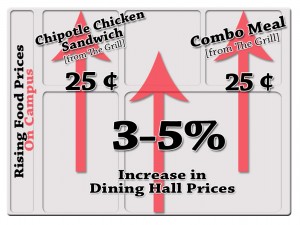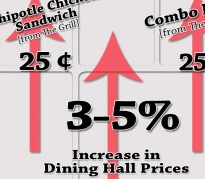 St. Thomas students will be paying 3 to 5 percent more to eat at campus dining halls this year due to rising food costs.
St. Thomas students will be paying 3 to 5 percent more to eat at campus dining halls this year due to rising food costs.
Some of the increases in food cost are due to a raise in food quality. For example, both Scooter’s and the Grill will feature higher quality fries this semester, Todd Empanger said.
Junior Courtney Brown said the rising prices on campus disappointed her but hearing that the school is maintaining and even improving its food quality made her “feel a little bit better.” She said that she won’t be doing anything differently when paying a higher price for some of her favorite items on campus.
“I am happy with the food here,” Brown said.
Likewise, senior Lukasz Wlosiak said the increase in prices will go along with an increase in food quality.
“That’s what we are hoping for. As a senior, I will just do what I have done in the past years and I will keep purchasing the same items I have already tried and already like,” Wlosiak said.
However, some students are not pleased with the new prices.
“In general, I’m not happy about it,” junior Kathleen Dempsey said. “It’s hard being a student and affording it.”
Senior Shannan Peifer agrees.
“I already thought it was pretty expensive the way it was,” she said.
Dining Services Director Todd Empanger said that prices were frozen for three years, but the St. Thomas Dining Services must follow the trend after a poor economy, ruthless weather and increasing energy costs have driven up the prices on food.
“We try to limit it on where we place the expenses or increases, but it’s due to the cost increases on just raw product,” Empanger said .
He also said the school has expenses that need to be met because of the market and economy.
“Corn prices have skyrocketed, which trickles down into the beef commodity markets and everywhere else,” Empanger said.
Cash Operations Manager Gayle Lamb said Dining Services has tried to avoid rising cost on food due to transportation by buying high quality products locally.
“We get charged a fuel surcharge on some of our invoices to compensate for the increase in fuel,” she said, “but also it’s built into the cost of the products we purchase.”
Dining locations on campus have started featuring products from the Stewardship Garden growing food on South Campus.
“Mother Nature’s been tough on the farmers and on the markets,” Lamb said.
Items from the Stewardship Garden have saved on transportation costs on expensive food from other weather-struck areas and still allows for a high quality product.
“Even if the school has to pay expensive prices,” Lamb said. St. Thomas “doesn’t want to serve a low quality product. It just doesn’t pay.”
With all of the changes occurring in food services, students are spilt on whether or not they’ll spend their money eating at Scooter’s and the Grill versus going off-campus.
“I’m not going to go out of my way or avoid eating here just because it has a 3 to 5 percent price increase,” senior Mike McCool said.
Dempsey believes that the price change won’t affect her eating habits.
“I’m pretty dependent on eating on campus,” she said. “But I’ll probably get less; So instead of getting a pop, I’ll just always get water.”
Peifer plans to spend her money elsewhere.
“I can go to Subway and get like ten times the amount of food for cheaper,” she said.
While the future of the market is unpredictable, Dining Services plans to hold on to these new prices a long as possible and into the new facilities at the Anderson Student Center. The department also encourages students to communicate with them on how they may better serve the St. Thomas.
Mellaney Peper can be reached at pepe0923@stthomas.edu.



